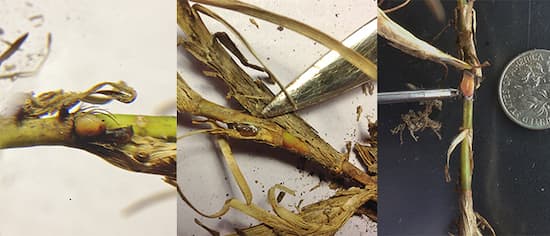Lawn Pest Alert In North Myrtle Beach & Surrounding Areas

Now that spring has finally arrived, many local homeowners are getting outside and starting the task of grooming their lawns for the upcoming growing season. However, if you have noticed dead spots in your North Myrtle Beach lawn, or you find that you can easily pull up areas of your Centipede lawn, only to find that the root system is completely gone, it could be a telltale sign of insect damage from a particular type of pest that has been springing up more and more commonly in the local area. We're talking about the Rhodesgrass Mealybug. Although they are more commonly found down in the Gulf states, they have started to make appearances recently in Centipede lawns throughout North Myrtle Beach and the surrounding areas according to the county extension service. Our team of landscaping professionals here at Seagreen Lawn Care and Irrigation Inc. actually found the samples you will see below while on the job in late March.
What Are Rhodesgrass Mealybugs?
While they have been found in Centipede lawns recently, Rhodesgrass Mealybugs have a wide range of host grasses, including Bermudagrass, St. Augustinegrass, and Tall Fescue as well. Rhodesgrass Mealybugs typically feed under leaf sheaths, on nodes, or in the crowns of your grass. With their piercing-sucking mouthparts, they disrupt your lawn's vascular system, inhibiting their water and nutrient uptake, which usually results in discoloration, and will eventually lead to wilting, and even death. With heavy infestations, the effects are even more pronounced, and you can sometimes notice masses of waxy, white secretions, along with honeydew and sooty mold on your lawn. Rhodesgrass Mealybugs are often most active, and do the most damage in sunny locations during hot, dry periods.
How Do I Control Them & Prevent Damage To My Lawn?
If you suspect that your grass is being destroyed by Mealybugs, the first thing you need to do is to make sure you collect and destroy all grass clippings, or to have your landscaping professional do so, in order to help prevent the infestation from spreading around your lawn more so than it already has. In order to eliminate their spread and prevent any further damage to your lawn, specific and thorough insecticide treatments are needed. In order to get the right balance of insecticide and to ensure it is properly applied to your lawn, however, you are going to want to have a professional come in an do so. If you need assistance with your lawn in North Myrtle Beach or the surrounding areas, contact us today. Let our team of landscaping professionals help you take back your lawn from these damaging pests.
